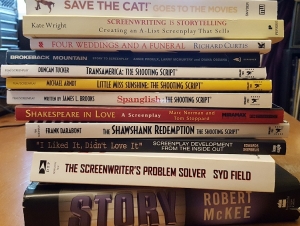The Good, the Bad and the Ugly Truth of Rom-Coms
SPOILER ALERTS: There are many in here. Be warned.
by Renée J. Lukas
As we say a final farewell to February, I wanted to do a blog in honor of this past month—the month of Valentine’s Day, Cupid (or just a man-baby in a diaper), and love and romance. So today’s blog is about romantic comedies. Okay, time to come clean. The real reason I’m talking about rom-coms is because I’ve accidentally watched a lot of them lately. I say “accidentally,” because I’d be flipping through Netflix in a very low-e xpectation kind of mood, and if I ran across one I’d heard of but hadn’t yet seen, I was like, “Eh, what the hell.” My expectations were so low because many films in this genre feel formulaic, not at all reaching the level of what I’d consider some of the greats—When Harry Met Sally, Sleepless in Seattle, Moonstruck, Arthur, Notting Hill, Love Actually, and Four Weddings & A Funeral. What made these work so well was 1) good writing, and 2) a willingness to defy conventions.
xpectation kind of mood, and if I ran across one I’d heard of but hadn’t yet seen, I was like, “Eh, what the hell.” My expectations were so low because many films in this genre feel formulaic, not at all reaching the level of what I’d consider some of the greats—When Harry Met Sally, Sleepless in Seattle, Moonstruck, Arthur, Notting Hill, Love Actually, and Four Weddings & A Funeral. What made these work so well was 1) good writing, and 2) a willingness to defy conventions.
I’d like to add another film to that list: Something’s Gotta Give. This one also defies convention by featuring a couple who isn’t twenty years old. That in itself is revolutionary. For a writer, using characters that are older gives you much more to work with. You can imbue them with life experiences that present problems for their relationship. You can even have an iconic scene where a jubilant Diane Keaton throws a blood pressure cuff up to the rafters like Mary Tyler Moore’s hat, and the meaning is clear—this woman, who didn’t know if all of her parts still worked anymore, learns that her partner is medically cleared to have sex, which means she’s going to have a good time for the first time in years. But my favorite part is a scene earlier in the film when Jack Nicholson accidentally sees her naked, and she can’t be around him afterward without wearing hats and glasses. No actress does neurotic as well as Diane Keaton.
Where are the LGBT characters?
Another pet peeve of mine is that they’re usually boy meets girl. We LGBT viewers never get to see any same-sex love on the big screen unless it’s Brokeback Mountain. And how long ago was that? And it certainly wasn’t a comedy. A film like Imagine Me & You finally gave us a girl-gets-the-girl comedy, but it didn’t have as broad a distribution. It’s as if the moment you insert a lesbian couple into the mix, the film automatically goes into the “art house” or, let’s be honest, marginalized category. Don’t get me wrong. I like independent films. But let’s not kid ourselves that they get the same level of attention as mainstream, big studio films do.
So back to the romantic comedies I wandered upon this past month. . .
Someone Like You tells the story of Jane Goodale (Ashley Judd) who, after getting dumped by the Greg Kinnear character, finds herself eventually falling for her womanizing roommate, Eddie, played by Hugh Jackman. (As if we didn’t see THAT coming.) After apparently returning Jane’s feelings, there’s a scene in which Eddie berates her for her skepticism about him—this from a man who is known to have more casual sex than a hooker. Of course, Jane then begins to doubt herself and her own issues about men (a.k.a. an old cow theory). But I’d like to tell her that no doubt is necessary. Not trusting Eddie is just good judgment. So when they got together I didn’t care. Really. Didn’t care. I also really dislike comparisons of women to cows. Maybe that’s my own personal issue. But whatever. Moving on. . .
Bridget Jones: The Edge of Reason was another film I watched with my mouth open, wondering why the title character would even consider staying with her boyfriend. I vaguely remembered the first film and that she was a fun character, so I thought, what the heck. I can’t call it formulaic, because I was constantly surprised that Bridget would be dumb enough to stay in her relationship and really didn’t expect the ending. Here’s what happened: Mark Darcy (Colin Firth) is actually not Mr. Right. He’s Mr. Disaster. Darcy seems to cringe in horror at everything Bridget Jones (Renée Zellweger) does. He’s clearly a snob who is embarrassed by her. Oh, and just when you think they’re the worst match ever, he suddenly tells her he loves her, which seems totally out of character. When they talk of their future, she doesn’t want her kids to be stuffed shirts (like him), but he wants their children—a son, of course—to go to the finest snobby school that he did. Enter Hugh Grant, the bad boy womanizer she’s supposedly learned her lesson about. He starts to look like the good one, right up until it’s clear he’s taken her to Thailand simply to get in her pants. And if he’d failed in his task, he had a back-up hooker scheduled. Unfortunately for him, just as Bridget is about to lose her mind and go to bed with him, he realizes he’s forgotten to cancel his nightly “appointment” until she comes to the door. A few other things happen to make it clear that Grant’s character isn’t the one she should be with. By this time, I was rooting for a third option, because really, neither of them deserves her. I’ll give them props for the nice lesbionic twist at the end. Spoiler: Who saw it coming that Darcy’s “friend” had her eye on Bridget? If only she could’ve turned her. She might have been happier in the long run. . . Of course I’m kidding. Bridget can’t help that she’s straight. She was born that way. Moving on. . .
The Five-Year Engagement was more drama than comedy, and frankly, it stressed me out. Tom Solomon (Jason Segel) is at the top of his game as a chef who is about to be promoted at a new restaurant in San Francisco. However, the love of his life, Violet Barnes (Emily Blunt), is offered a graduate internship at the University of Michigan. He agrees to give up his career to move with her and make sandwiches at some place in Michigan. He’s miserable, growing a beard and finding new ways to hunt and cook venison. It’s depressing, actually. After you invest two hours in their relationship, seeing how the sacrifices he makes change both of them, they eventually persevere. And yes, I know love is more important than where they live, but you never find out where they end up living! Enquiring minds wanted to know—for two hours! I voted for San Francisco, although I’ve met many nice people from Michigan. But the film never answers the question posed by the story. Frustrating with a capital “F.”
Kate & Leopold was more enjoyable, even though you knew from the title they would end up together. What the story did well was to keep it a mystery as to how they would end up together. The premise was more original, too, as long as you can keep your head out of reality for a while. Leopold (Hugh Jackman) is a Duke from the 1800s who invented the elevator. He accidentally follows a scientist through a portal in time, and finds himself in present-day New York City. Of course he’s terrified by things like answering machines, toasters, microwaves, and amazed that the Brooklyn Bridge has finally been finished. Kate McKay (Meg Ryan) is a cynical marketing research professional who is about to get promoted. Through the course of the story, she falls in love with Leopold, despite the fact that he speaks very strangely and bluntly insults her for wearing pants. Spoiler Alert: The hardest part of the story to swallow is the idea that she’ll give up everything in the modern world to go back in time with Leopold. If you think too much about it, well, the whole thing is ridiculous. I consider myself a romantic, but it’s hard to imagine that reality wouldn’t eventually catch up with Kate. I mean, really. Would you trade modern conveniences for no working toilets or sanitary feminine products? And by the way, she would not only be prohibited from being a vice-president at a company, she wouldn’t even have the right to vote!
Under the Tuscan Sun is one of the most unexpectedly romantic movies ever, even though Frances (Diane Lane) doesn’t meet her true love until the very end. It’s different because the one you think she’ll be with isn’t the “one.” Unfortunately, Marcello is a guy who can’t keep a relationship going if the woman’s plans don’t revolve around him. But it’s not about Marcello and his funny attempts to speak American slang: “You think I’m just trying to pull you up.” Ha! The film is romantic in the setting, in the little details—the old man who leaves flowers for someone we’ll never know, the idea of creating a beautiful house out of rubbish, and the relationships forged over the course of the story. Even the character of Katherine played perfectly by Lindsay Duncan is a romantic character who shows up right at those key moments in Frances’s life. When Frances is considering purchasing an old house in Tuscany, Katherine breezes by with an ice cream cone dribbling onto her hands. When Frances tells her that buying a house there is a terrible idea, Katherine responds: “Terrible idea. Don’t you just love those?” This is a movie to put on whenever you want to feel truly transported, with a story that moves at a pace most like real life, though never boring.
So that wraps up this brief exploration of romantic comedies, some old, some new. In all fairness, it’s never easy to find new ways to surprise an audience. Romantic comedies have the hardest task, because you see the two names in the credits and you assume they will eventually get together. I read somewhere that the key to a successful ending is to make it a surprise that feels inevitable. Yeah, right. And let’s find some cheap beachfront property. It isn’t easy. But having said that, it’s time to break out of formulas and find some new ways of telling a story, especially if it’s a romantic comedy.
